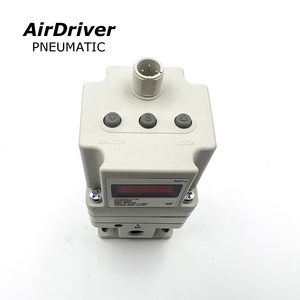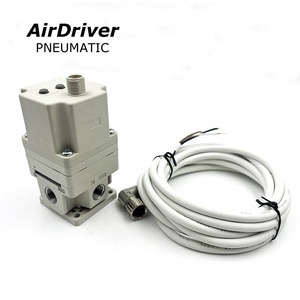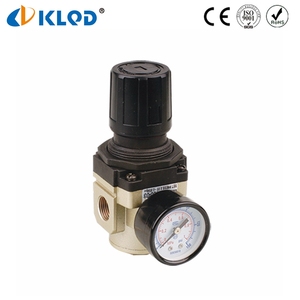
All categories
Featured selections
Trade Assurance
Buyer Central
Help Center
Get the app
Become a supplier

(12313 products available)















A vacuum pressure regulator is a device that controls the flow and pressure of gasses or liquids in pipelines. Different types of vacuum pressure regulators perform various functions, as shown below.
Spring-loaded Vacuum Pressure Regulator
Spring-loaded vacuum pressure regulators work by using a spring that is preloaded to a certain level. The spring is pushed by the flow or pressure of the gas or liquid. When the force from the fluid or gas exceeds the spring preload, it overcomes the spring force and allows the valve to open, thus letting more material through the pipeline.
Electro-Mechanical Vacuum Regulators
The electro-mechanical vacuum pressure control valve works differently. Electro-mechanical vacuum pressure regulators have a small electric motor inside them. This motor's job is to move the valve up or down. When the motor moves the valve up, it allows less fluid or gas to pass through. When it moves down, it permits more fluid or gas to go through.
Pilot-operated Pressure Vacuum Regulator
Pilot-operated pressure vacuum regulators are more complex. They have a small controller inside them called a pilot. The pilot controls a larger main valve. It does this by changing the pressure from a small vent opening. When the pilot senses the upstream pressure is low, it increases pressure on the main valve to let more fluid through.
Somekey specifications vacuum pressure regulators include pressure rating, material construction, operating temperature, flow rate, connection size, and type.
Retaining the efficiency of a vacuum pressure regulator in flow controlrequires proper maintenance. Failure to maintain appropriately can lead toimpending system components or complete dysfunctional vacuum regulators. Somekey maintenance requirements include:
The application of vacuum pressure regulators can be observed in various industries and fields.
Pharmaceutical industry:
In the pharmaceutical industry, drugs need to be packaged in an airtight and sterile manner so that there is no contamination of any kind that could affect the quality of the medicine. That's where medical vacuum regulators come in. By providing a constant flow of suction through the packaging machine doors, these medical devices help create vacuum-filled packages.
Food packaging:
In the food industry, vacuum pressure controls can be used for the vacuum sealing of food packaging. Operating vacuum sealers at a consistent level helps to extend food shelf life and reduce packaging errors. Therefore, consumers are assured of quality and freshness.
Laboratories/Research:
In laboratory and research settings, vacuum pressure regulators can be used to control vacuum filtration systems and suction traps. These devices help researchers achieve accurate and reproducible results by providing stable suction strength. Additionally, they protect equipment and samples from over-vacuuming and contamination.
Automotive Industry:
In the automotive industry, vacuum pressure regulators can be used for vehicle maintenance and repair. For example, during car engine tuning and repairs, technicians need to conduct precise adjustments and calibrations of engine components using suction cups or vacuum-held parts. A consistent suction force provided by a vacuum pressure control valve allows auto technicians to achieve accurate and reliable repairs and adjustments.
Mechanical Manufacturing:
In the field of mechanical manufacturing, vacuum pressure controllers are commonly used for precision machining. For example, when machining and processing small and complex mechanical components or parts, the workpieces need to be held firmly and steadily. By providing a constant vacuum pressure, the vacuum pressure control helps hold the workpieces, ensuring accurate machining and fine workmanship.
Selection of vacuum pressure regulator requires consideration of a number of aspects in order to ensure that the appropriate model has been chosen for the individual application at hand.
Q1: How do vacuum regulators work?
A1: Vacuum regulators work by controlling the airflow into the intake manifold through a throttle valve. They achieve this by adjusting the size of the opening on the hose connected to the vacuum source. When the engine runs at a high rpm, the atmospheric pressure is higher than the pressure in the intake manifold. This difference in pressure causes the vacuum to pull on the throttle valve, allowing the valve to adjust the opening size to let more air in.
Q2: Why are vacuum regulators used?
A2: Vacuum regulators are used to ensure consistent and accurate gun spraying pressure. They prevent changes in spray painting pressure caused by changes in the spray gun's operating vacuum. Maintaining constant pressure improves paint spray quality, reduces paint transfer loss, and minimizes the amount of overspray.
Q3: What are the symptoms of a failing vacuum pressure regulator?
A3: The symptoms of a bad vacuum pressure regulator include an increase in the amount of fuel being burnt, engine stalls, rising and falling engine speeds, whistling sounds from the vacuum hoses, and constant checking engine light.
Q4: Can a vacuum pump reduce carbon buildup?
A4: Carbon buildup in the intake manifold and on the intake valves is a concern for direct injection engines. Utilizing a vacuum pump can help mitigate this issue by creating a suction force that cleans off the carbon deposits.
Q5: What is the difference between a regulator and a controller?
A5: The main difference between a vacuum controller and regulator is that a controller is designed to handle high flows, while a regulator is typically used to handle low flows. Additionally, a controller is capable of modulating the pressure delivered to the end user, whereas a regulator can only maintain a fixed pressure.